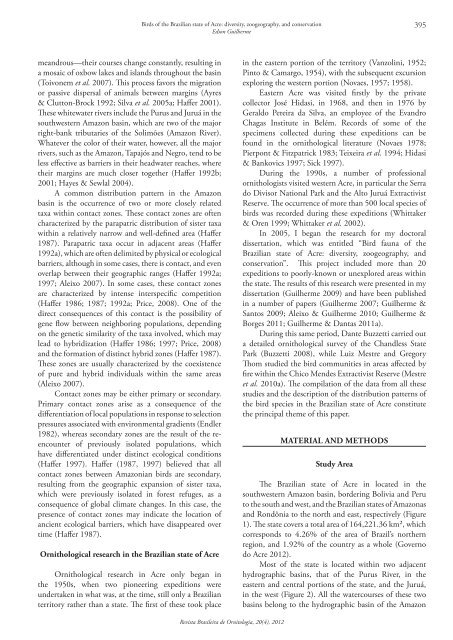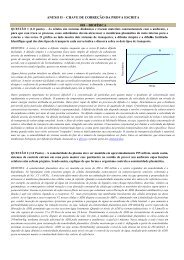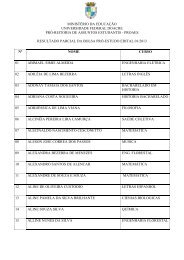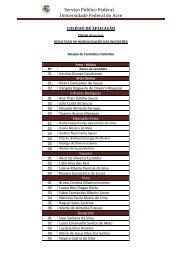Revista Brasileira de Ornitologia - Universidade Federal do Acre
Revista Brasileira de Ornitologia - Universidade Federal do Acre
Revista Brasileira de Ornitologia - Universidade Federal do Acre
Create successful ePaper yourself
Turn your PDF publications into a flip-book with our unique Google optimized e-Paper software.
Birds of the Brazilian state of <strong>Acre</strong>: diversity, zoogeography, and conservationEdson Guilherme395meandrous—their courses change constantly, resulting ina mosaic of oxbow lakes and islands throughout the basin(Toivonem et al. 2007). This process favors the migrationor passive dispersal of animals between margins (Ayres& Clutton-Brock 1992; Silva et al. 2005a; Haffer 2001).These whitewater rivers inclu<strong>de</strong> the Purus and Juruá in thesouthwestern Amazon basin, which are two of the majorright-bank tributaries of the Solimões (Amazon River).Whatever the color of their water, however, all the majorrivers, such as the Amazon, Tapajós and Negro, tend to beless effective as barriers in their headwater reaches, wheretheir margins are much closer together (Haffer 1992b;2001; Hayes & Sewlal 2004).A common distribution pattern in the Amazonbasin is the occurrence of two or more closely relatedtaxa within contact zones. These contact zones are oftencharacterized by the parapatric distribution of sister taxawithin a relatively narrow and well-<strong>de</strong>fined area (Haffer1987). Parapatric taxa occur in adjacent areas (Haffer1992a), which are often <strong>de</strong>limited by physical or ecologicalbarriers, although in some cases, there is contact, and evenoverlap between their geographic ranges (Haffer 1992a;1997; Aleixo 2007). In some cases, these contact zonesare characterized by intense interspecific competition(Haffer 1986; 1987; 1992a; Price, 2008). One of thedirect consequences of this contact is the possibility ofgene flow between neighboring populations, <strong>de</strong>pendingon the genetic similarity of the taxa involved, which maylead to hybridization (Haffer 1986; 1997; Price, 2008)and the formation of distinct hybrid zones (Haffer 1987).These zones are usually characterized by the coexistenceof pure and hybrid individuals within the same areas(Aleixo 2007).Contact zones may be either primary or secondary.Primary contact zones arise as a consequence of thedifferentiation of local populations in response to selectionpressures associated with environmental gradients (Endler1982), whereas secondary zones are the result of the reencounterof previously isolated populations, whichhave differentiated un<strong>de</strong>r distinct ecological conditions(Haffer 1997). Haffer (1987, 1997) believed that allcontact zones between Amazonian birds are secondary,resulting from the geographic expansion of sister taxa,which were previously isolated in forest refuges, as aconsequence of global climate changes. In this case, thepresence of contact zones may indicate the location ofancient ecological barriers, which have disappeared overtime (Haffer 1987).Ornithological research in the Brazilian state of <strong>Acre</strong>Ornithological research in <strong>Acre</strong> only began inthe 1950s, when two pioneering expeditions wereun<strong>de</strong>rtaken in what was, at the time, still only a Brazilianterritory rather than a state. The first of these took placein the eastern portion of the territory (Vanzolini, 1952;Pinto & Camargo, 1954), with the subsequent excursionexploring the western portion (Novaes, 1957; 1958).Eastern <strong>Acre</strong> was visited firstly by the privatecollector José Hidasi, in 1968, and then in 1976 byGeral<strong>do</strong> Pereira da Silva, an employee of the EvandroChagas Institute in Belém. Records of some of thespecimens collected during these expeditions can befound in the ornithological literature (Novaes 1978;Pierpont & Fitzpatrick 1983; Teixeira et al. 1994; Hidasi& Bankovics 1997; Sick 1997).During the 1990s, a number of professionalornithologists visited western <strong>Acre</strong>, in particular the Serra<strong>do</strong> Divisor National Park and the Alto Juruá ExtractivistReserve. The occurrence of more than 500 local species ofbirds was recor<strong>de</strong>d during these expeditions (Whittaker& Oren 1999; Whittaker et al. 2002).In 2005, I began the research for my <strong>do</strong>ctoraldissertation, which was entitled “Bird fauna of theBrazilian state of <strong>Acre</strong>: diversity, zoogeography, andconservation”. This project inclu<strong>de</strong>d more than 20expeditions to poorly-known or unexplored areas withinthe state. The results of this research were presented in mydissertation (Guilherme 2009) and have been publishedin a number of papers (Guilherme 2007; Guilherme &Santos 2009; Aleixo & Guilherme 2010; Guilherme &Borges 2011; Guilherme & Dantas 2011a).During this same period, Dante Buzzetti carried outa <strong>de</strong>tailed ornithological survey of the Chandless StatePark (Buzzetti 2008), while Luiz Mestre and GregoryThom studied the bird communities in areas affected byfire within the Chico Men<strong>de</strong>s Extractivist Reserve (Mestreet al. 2010a). The compilation of the data from all thesestudies and the <strong>de</strong>scription of the distribution patterns ofthe bird species in the Brazilian state of <strong>Acre</strong> constitutethe principal theme of this paper.MATERIAL AND METHODSStudy AreaThe Brazilian state of <strong>Acre</strong> in located in thesouthwestern Amazon basin, bor<strong>de</strong>ring Bolivia and Peruto the south and west, and the Brazilian states of Amazonasand Rondônia to the north and east, respectively (Figure1). The state covers a total area of 164,221.36 km², whichcorresponds to 4.26% of the area of Brazil’s northernregion, and 1.92% of the country as a whole (Governo<strong>do</strong> <strong>Acre</strong> 2012).Most of the state is located within two adjacenthydrographic basins, that of the Purus River, in theeastern and central portions of the state, and the Juruá,in the west (Figure 2). All the watercourses of these twobasins belong to the hydrographic basin of the Amazon<strong>Revista</strong> <strong>Brasileira</strong> <strong>de</strong> <strong>Ornitologia</strong>, 20(4), 2012










